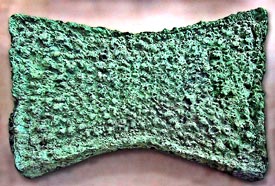The Art of Early Copper Tools
 Copper ingot from Zakros, Crete
Copper ingot from Zakros, CretePhoto by Archaeological Museum of Herakleion
Although the Sumerian city-states in the Middle East were actually considered the first great metal users, the art of crafting copper tools has a long legacy in the history of several early civilizations across the globe.
In Egypt, copper may have been the first metal used. The 12% copper content were extracted in the ores, and large selections of tools were formed including wood and stone. But, thanks to tempering, copper chisels and saws were used to work freshly quarried limestone from the 4th dynasty onwards.
Copper was also found in the tomb of the queen of Pharaoh Snefru, from the Second Dynasty in Egypt. However, it wasn't until the third dynasty that copper tools were used to build stone pyramids. Copper was mined by the Egyptians in the Sinai Peninsula, making it the first real industry of the ancient world. Early Egyptian graves contained copper saws, needles, scissors, pincers, axes, harpoons, arrow tips, and knives. Malachite, Azurite, and Turquoise, still worn by today's savvy women, also had its inception in the Sinai. Inscriptions to "the Goddess Hathor, the Lady of the Turquoise" are still found in the Sinai. In Gerza, located on the Nile River south of Cairo, Gerzeans developed a civilization based on the metallurgy of copper. In approximately 3500 B.C., they learned basic copper metallurgy from Mesopotamian immigrants.
In America, during the 17th, 18th and early 19th centuries, copper was still an important metal for various tools. Henry Chapman Mercer, of Doylestown, PA, collected many such artifacts of Americana and exhibited them in his eponymous castle-like concrete museum, owned by the Bucks County Historical Society.
"Aside from a copper sickle blade we don't have many true Bronze Age tools here, since our collections, for the most part, represent 18th and early 19th century European and American implements," explains Cory Amsler, Vice President for Collections and Interpretation. "However, copper and its alloys were absolutely vital to numerous tools and implements used in early America."
Among its collections, the Mercer Museum boasts many such copper-based artifacts - teakettles, cooking vessels, balance scales, bed-warmers, bloodletting devices, fireplace tools, speaking horns, harness bells, surveyor's compasses, measuring instruments, ladles and skimmers, whiskey stills, soldering irons and more.
"Because of its resistance to corrosion and its non-sparking properties, copper and its alloys were also used in shipbuilding, and for tools used around gunpowder or other explosive materials," notes Amsler.
Amsler added that even before Europeans brought smelting technology to North America, some settlers used copper for an assortment of tools and decorative items. Native cultures around the Great Lakes and in the American southwest, for example, were able to extract copper for ore, which they hammered and worked in raw form to create useful and beautiful artifacts.
Resources:
Also in this Issue:
- The Lee Robertson Method of Copper Arts
- Still Life on Copper: The Process of Discovery
- How a Historic Cupola Became Copper Art
- The Art of Early Copper Tools
- Cast Images: American Bronze Sculpture Highlights New York Works
